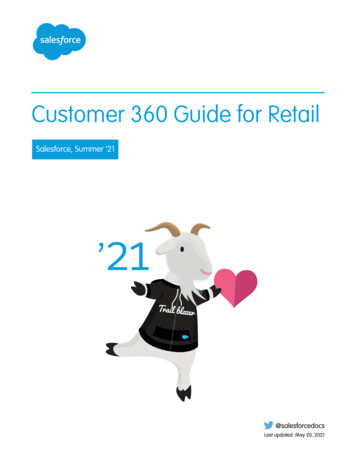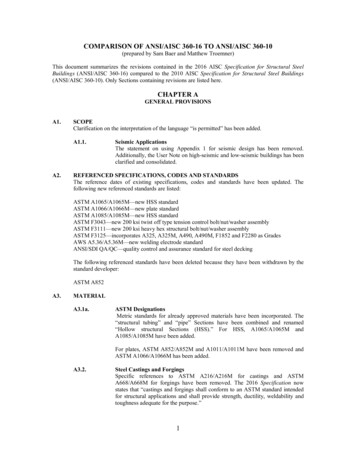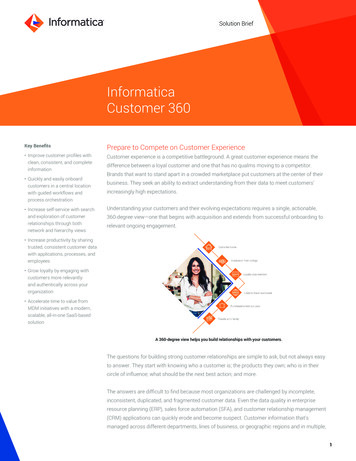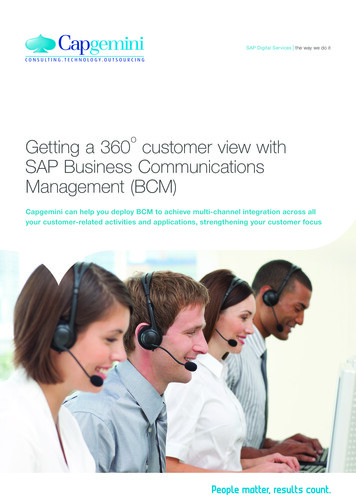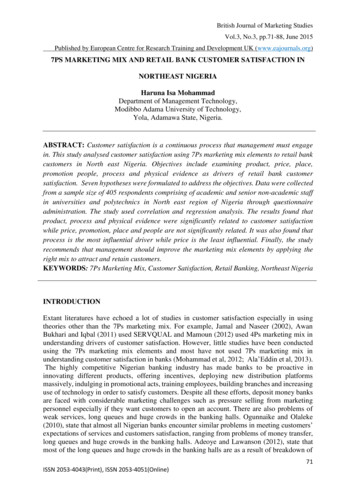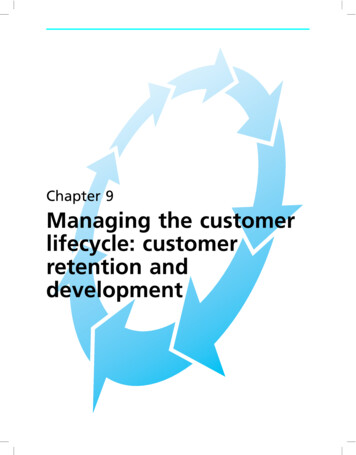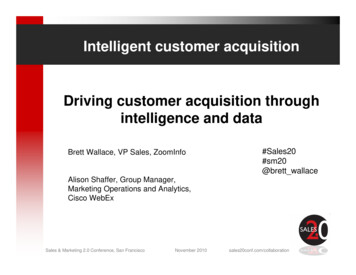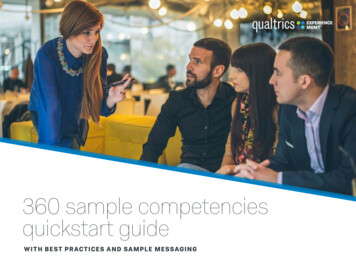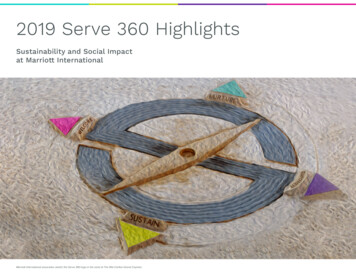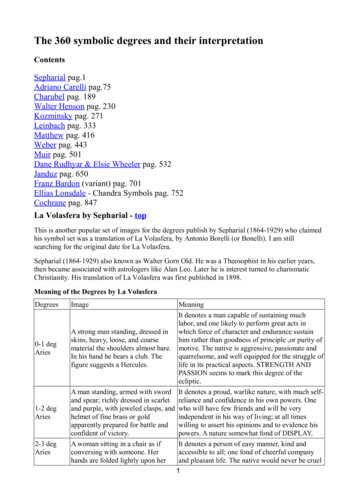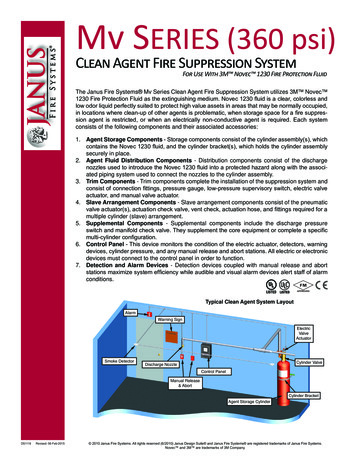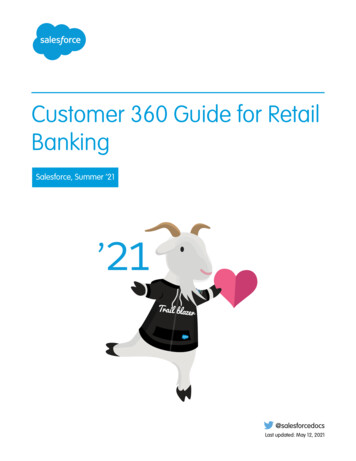
Transcription
Customer 360 Guide for RetailBankingSalesforce, Summer ’21@salesforcedocsLast updated: May 12, 2021
Copyright 2000–2021 salesforce.com, inc. All rights reserved. Salesforce is a registered trademark of salesforce.com, inc.,as are other names and marks. Other marks appearing herein may be trademarks of their respective owners.
CONTENTSCustomer 360 Guide for Retail Banking . . . . . . . . . . . . . . . . . . . . . . . . . . . . . . . . . . . . 1Industry Blueprint for Retail Banking . . . . . . . . . . . . . . . . . . . . . . . . . . . . . . . . . . . . . . . . . . 1Reference Architecture for Retail Banking . . . . . . . . . . . . . . . . . . . . . . . . . . . . . . . . . . . . . . 3Solution Architecture for Retail Banking . . . . . . . . . . . . . . . . . . . . . . . . . . . . . . . . . . . . . . . 6Business Scenarios for Retail Banking . . . . . . . . . . . . . . . . . . . . . . . . . . . . . . . . . . . . . . . 12Explore Solution Kits for Retail Banking . . . . . . . . . . . . . . . . . . . . . . . . . . . . . . . . . . . . . . . 47
CUSTOMER 360 GUIDE FOR RETAIL BANKINGOptimize your onboarding and service processes to become the bank your customers love.The assets in this Customer 360 Guide help you build a vision and make a plan for digital transformation in the retail banking industry.Learn with TrailheadArchitectural diagrams and business scenarios show you how Salesforce products combine with industry best practices to expand yourbusiness capabilities. Solution Kits show you how to implement Salesforce-recommended cross-cloud solutions to common retail usecases.Industry Blueprint for Retail BankingExamine the Salesforce view of strategy, product innovation, and partner relationships to enable front-end and back-end businessprocesses in retail banking.Reference Architecture for Retail BankingMap specific Salesforce products to the functional capabilities and operational activities of the retail banking industry.Solution Architecture for Retail BankingIdentify the specific tools and resources that can help you deliver comprehensive automation solutions for your retail bankingbusiness.Business Scenarios for Retail BankingBusiness scenarios help you bridge the gap between your organization's business capabilities and the solutions needed to achieveyour goals. For each scenario, discover a variety of Salesforce solutions that reduce your time to value and allow you to define aroadmap to build out your organization’s functionality.Explore Solution Kits for Retail BankingEnhance your cross-cloud business by implementing one or more solution kits. Get product recommendations, workflow details,and instructions to help you implement the solution from start to finish.SEE ALSO:Customer 360 Guide for Discrete Manufacturing Learning MapCustomer 360 Guide for Retail Learning MapCustomer 360 Guides: Quick LookIndustry Blueprint for Retail BankingExamine the Salesforce view of strategy, product innovation, and partner relationships to enable front-end and back-end businessprocesses in retail banking.The retail banking blueprint is a type of reference architecture that describes the end-to-end customer lifecycle. Use the industry blueprintto understand how Salesforce Customer 360 platform capabilities help structure, organize, and support digital transformation. Map customer-facing business capabilities that are common to retail banking to the stages of the customer lifecycle across marketing,sales, customer onboarding, origination, and fulfillment, through to servicing and the post-sales experience. Determine which capabilities are most important to your organization and prioritize implementation accordingly. Organize projects that deliver business value with maximum benefit.1
Customer 360 Guide for Retail BankingIndustry Blueprint for Retail Banking Gain alignment among key business process stakeholders. Understand the high-level platform capabilities and the Salesforce partners needed to power your organization’s business needs.Contact your Salesforce account team or a Salesforce partner for help with assessing the business and platform capabilities most suitedfor your organization.The typical lifecycle of a retail banking customer relationship has eight phases, from pre-sales marketing to relationship renewal.Marketing and sales process management capabilities help retail banks acquire new relationships and deepen existing ones. Market: Retail banks require marketing capabilities to drive acquisition, customer support, and marketing operations strategies. Lead: Banks identify, segment, and nurture leads. Prospect: After a lead shows interest or a referral agrees to be contacted, sales activities focus on understanding the customer’sneeds and identifying products and services to recommend.Onboarding, origination, and fulfillment capabilities include traditional compliance capabilities, building an understanding of thecustomer, and connecting customers with products and services. Customer: Banks develop a deeper understanding of customer preferences. Compliance checks performed at this time are critical. Deposits and Lending: Origination, underwriting, documentation, and booking and funding processes are completed. Services: Banks set up services associated with a newly booked account, enable customers for those services, and execute documents.Customer support plus renew and grow capabilities address customer needs as they evolve. Customer Support: Service levels vary depending on customer needs. Support includes basic transaction inquiries to researchingmore complex service needs, which can include complaint resolution.2
Customer 360 Guide for Retail BankingReference Architecture for Retail Banking Renew and Grow: Banks deepen connections with customers and grow relationships by advising on changing service needs.Salesforce partners with independent software vendors (ISVs) and consultants to extend platform capabilities to suit business processes.Industry-specific integrations and complete solutions are also available from retail banking fintechs. To learn more about ready-to-installapplications, solutions, or consultants, check out AppExchange.Note: To understand how industry and business requirements link to the technologies that support them, review the RetailBanking Reference Architecture. Use the industry blueprint as a framework to create a reference architecture for planning customerexperience enhancements.Standard Salesforce platform capabilities include platform enablers and API and data sources for all stages of the retail banking customerlifecycle. These foundation capabilities support custom-built solutions.Note: To understand which business capabilities, solutions, and Salesforce products can help your organization achieve thebusiness needs identified on the blueprint, review retail banking business scenarios.SEE ALSO:Industry Blueprints for PartnersReference Architecture for Retail BankingSolution Architecture for Retail BankingSalesforce Architectural Diagrams: Quick LookReference Architecture for Retail BankingMap specific Salesforce products to the functional capabilities and operational activities of the retail banking industry.Salesforce provides configurable product solutions that support a banking institution’s ability to engage their customers effectively. Thereference architecture helps communicate the vision and strategy of a solution to business executives and stakeholders. Learn withTrailhead.3
Customer 360 Guide for Retail BankingReference Architecture for Retail BankingConceptualize business success in each of three categories of capabilities: Foundational, Platform, and Functional.Our reference architecture presents Platform and Functional capabilities. Each layer contains a representative subset of systems orcapabilities that are most relevant for Retail Banking industry. It doesn’t list all possible systems or capabilities.Platform CapabilitiesThese components form the underlying technology base for achieving your goals. Each layer in the platform builds on top of the next.B2B and B2C systems typically rely on these elements.Data SourcesData sources are systems that create, collect, and manage various types of data. These systems can act as systems of record. They’reoften purpose-built to handle particular functionality and data requirements. Some address general system needs.IntegrationsIntegrations include tools and routes that connect systems of record with each other or with higher-level experiences. Integrationsare varied tools, such as APIs that connect separate systems, single sign-on services to manage customer identity across differentsystems, and customer data platforms to segment customers.Analytics and IntelligenceAnalytics helps you better understand your data and make smart business decisions. Smart automation like machine learning andAI helps you optimize your use of customer data. The intelligence layer serves functions like delivering actionable customer insights,personalized product recommendations, and improving real-time customer interactions to enhance your customer relationshipsand drive sales.Platform EnablersPlatform Enablers are a set of capabilities that enable your business to track customers as they interact with your bank based on theirpoint in the customer journey. The capabilities represent the day zero to lifetime engagement with a customer and support internalemployees as they onboard these customers.4
Customer 360 Guide for Retail BankingReference Architecture for Retail BankingFunctional CapabilitiesBusiness-specific elements at the functional capabilities level are connected more directly to the customer’s experience and measuredin terms of maturity. Successful implementation of functional capabilities depends heavily on implementation of the platform capabilities.The retail bank’s lifecycle typically crosses multiple engagement channels in the areas of Marketing, Sales, Onboarding, Servicing, andGrowing. Digital engagements and self-serve channels are necessary for the companies to address new business needs related to theCovid-19 pandemic.To identify strategic goals around which to focus your implementation, review these frequently required functional capabilities.A Business Capability Maturity Assessment arranged by your Success Manager or Account Executive can help you determine which areasof your business can benefit from more focus.Mapping Platform Capabilities to SalesforceSpecific Salesforce products handle each of the needs identified at the platform capability level.Identify gaps in your underlying capabilities by customizing this model to include other Salesforce products or third-party systems inyour current technology stack. To explore the reference architecture specific to your business, contact your success manager or accountteam.Tip: Business Scenarios on page 12 help you better understand your business capabilities and find solutions that support yourbusiness goals.Learn more about Salesforce products. Financial Services Cloud CPQ Mulesoft5
Customer 360 Guide for Retail BankingSolution Architecture for Retail Banking Commerce Experience Cloud Service Sales Analytics Work.com MarketingSEE ALSO:Salesforce Architectural Diagrams: Quick LookIndustry Blueprint for Retail BankingSolution Architecture for Retail BankingBusiness Scenarios for Retail BankingSolution Architecture for Retail BankingIdentify the specific tools and resources that can help you deliver comprehensive automation solutions for your retail banking business.Solution architecture diagrams show you how recommended products interoperate with backend systems and how data is passedbetween them. Learn with Trailhead.Retail Banking Solution Architecture with Key Clouds6
Customer 360 Guide for Retail BankingSolution Architecture for Retail BankingThe Salesforce Retail Banking architecture runs on two highly scalable and interoperable platforms: the core Salesforce Platform andSalesforce Marketing Cloud.Products built on the Salesforce Platform (1) include Financial Service Cloud, Vlocity, Tableau CRM, and Experience Cloud. These productsall operate on the same logical platform and share a flexible, common, and interoperable financial service data model. Financial Service Cloud is a superset of Sales Cloud and Service Cloud features customized for financial service firms. Financial ServiceCloud integrates sales, service, and marketing capabilities to provide a consistent experience across financial services departmentsand channels. The Lightning Platform provides an open set of APIs to enable integration with other Salesforce and non-Salesforce systems. Pre-builtconnectors such as Heroku go even further to enable other expedited integration options. The Salesforce Platform can be used in several ways. – As a customer master– As an editable or non-editable certified copy of customer master data– To integrate with a third Master Data Management systemThe Salesforce Marketing Cloud (2) is a powerful suite of communication and marketing automation tools designed for interoperability. Datorama offers deep marketing analytics. Interaction Studio provides real-time interaction management, personalization, and AI-drive recommendations. Social Studio enables social monitoring and social media interaction management. Pardot provides powerful email automation to help marketing and sales teams find and nurture the best leads, close more deals,and maximize ROI. Advertising Studio uses first-party data to shape and guide advertising. Audience Studio helps companies offer their customers a personalized advertising and media experience based on segmentationand audience Insights. Journey Builder stitches these tools together. It provides campaign management and delivers cross-channel, personalized experiencesat every step of the customer lifecycle.Tableau (3) is a business intelligence platform and has direct connections to the rest of the Salesforce ecosystem. Tableau providesanalytics independent of data sources.Mulesoft Anypoint Platform (4) is an integration platform designed for service-oriented architecture (SOA), Software as a Service (SaaS),and APIs. Mule ESB, CloudHub iPaaS, API Manager, and hundreds of SaaS and on-premises connectors and templates are the buildingblocks of this unique connectivity platform for integration. Use APIs to connect applications, data, and devices, both on-premises and in the cloud. Rearchitect a service-oriented architecture from legacy systems, proprietary platforms, and customer integration code. Migrate technology infrastructure to the public or private cloud, and prioritize adoption of SaaS applications and other cloudtechnologies. Deploy integrations in a hybrid environment, connecting to SaaS applications and on-premises systems.7
Customer 360 Guide for Retail BankingSolution Architecture for Retail BankingRetail Banking Solution Architecture with ConnectorsPre-built Salesforce connectors enable the connectivity that allows the cross-cloud actions required to support sophisticated use cases.These types of use cases include delivering a follow-up email based on customer inquiry about their financial goals.Marketing Cloud Connect (1) connects Marketing platform products with Sales and Service Cloud products. The connector quickly andeasily allows data to sync between these two clouds. It also allows Marketing Cloud products to trigger events such as emails and journeysbased on Financial Services Cloud data. Automatically sync data from Financial Services Cloud to Marketing Cloud. Connect Journey Builder to other clouds. Use Financial Services Cloud data to construct highly personalized emails. Provide Marketing Cloud email tracking data to Financial Services Cloud.Distributed Marketing (2) allows individual Financial Services Cloud users, such as financial service representatives, brokers, advisors, orloan officers, to view, personalize, and send on-brand, best practices content through Marketing Cloud. Use data stored in contact, lead, or person account records to address emails. Craft email to a segment of customers based on a specific filtered list. Send email about a campaign to a group of customers based on a touchpoint cadence managed by Marketing Cloud.Heroku Connect (3) syncs data between the Heroku app platform and the core Salesforce Platform. Create a data lake. Build, deploy, and run apps inside smart containers within a fully managed runtime environment. Heroku handles critical productionelements including configuration, orchestration, loan balancing, failovers, logging, and security. Create highly scalable customer facing mobile and web applications that sync usage and relevant data with Financial Services Cloud. Build data-driven apps with fully managed data services.8
Customer 360 Guide for Retail BankingSolution Architecture for Retail Banking Customer OnboardingRetail Banking Business Scenario Solution ArchitecturesThese solution architectures support and expand on the retail banking business scenarios included in this Customer 360 Guide.Solution Architecture for Retail Banking Customer OnboardingUnderstand key Salesforce architecture for building a customer profile and engaging AI to support customer acquisition.Banking Solution Architecture for Compliance ScenarioUnderstand key Salesforce architecture that helps retail banks improve their compliance and audit posture.Banking Solution Architecture for Digital Experiences ScenarioUnderstand key Salesforce architecture for supporting digital transformation in the retail banking industry.Banking Solution Architecture for Service Engagements ScenarioUnderstand key Salesforce architecture used to manage and close cases, engage customers with timely communications, and makesecure connections with remote systems.SEE ALSO:Salesforce Architectural Diagrams: Quick LookSolution Architecture for Retail Banking Customer OnboardingUnderstand key Salesforce architecture for building a customer profile and engaging AI to support customer acquisition.The process of seeding and growing a customer’s profile flows through four stages as the customer’s connection to the bank expands. An anonymous, unknown prospect identified as a single web browser A unique prospect identified by a cookie9
Customer 360 Guide for Retail BankingBanking Solution Architecture for Compliance Scenario A known, named lead Fully connected customer with a comprehensively populated customer recordIn the initial phase of the customer’s onboarding journey, Marketing Cloud (1) gathers information about the prospect’s expressedinterests based on their digital interactions and areas they visit. At this point, the customer can be a known individual or an anonymous,browsing prospect.Financial Services Cloud (2) incrementally captures more information about the prospect’s needs, interests, and product choices basedon their continued interactions. Financial Services Cloud and Marketing Cloud begin building a customer profile based on interactiondata, without directly asking the customer for any data.At the qualified lead stage, Einstein Intelligence (3) continually reviews the customer’s inferred or declared product interests and optimizesthe customer’s experience in real time. AI helps in making appropriate suggestions at the right time to move the customer along theirpurchasing journey.Banking Solution Architecture for Compliance ScenarioUnderstand key Salesforce architecture that helps retail banks improve their compliance and audit posture.Harness the built-in compliance framework within Financial Services Cloud (1) to capture, track, report, and manage compliance activities.Shield (2) provides enhanced audit trails for sensitive data, more logging and monitoring features with longer retention periods, andbring-your-own-key encryption for data at rest.Mulesoft (3) integrates with and respects the extra controls that Shield and Sales
Customer 360 Guide for Retail Banking Reference Architecture for Retail Banking. . Vlocity, Tableau CRM, and Experience Cloud. These products all operate on the same logical platform and share a flexible, common, and interoperable financial service data model. . personalization, and AI-drive recommendations.
